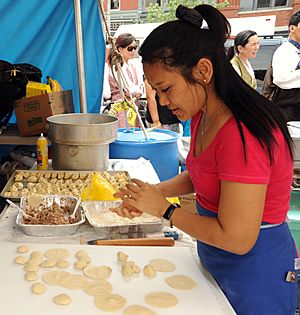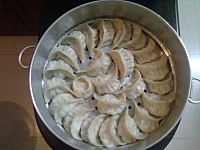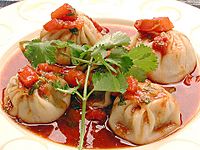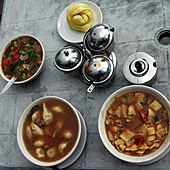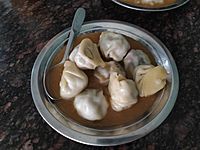Momo (food) facts for kids
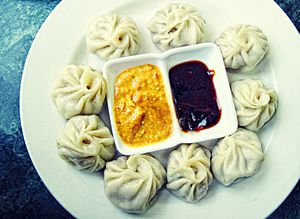
A typical serving of a plate of momo with sesame yellow sauce and red ginger chilli pickle.
|
|
| Region or state | Tibet, Sikkim, Kalimpong (India), Nepal |
|---|---|
| Main ingredients | White-flour-and-water dough; meat, vegetable, tomato aachar, soybean-perilla-peanut-sesame for Jhol aachar. |
| Variations | Steam-momo, Kothey momo, Jhol momo, C-momo, Fry-momo, Open-momo, fried momo |
| 350 to 1000 (35 to 100 per piece) kcal | |
| Similar dishes | baozi, jiaozi, mantou, buuz, gyoza, mandu, manti |
Momo are delicious bite-sized dumplings. They are made by wrapping a spoonful of tasty filling inside a soft dough. Most often, momo are cooked by steaming. But sometimes, they are fried or even steam-fried until crispy. The fillings, which can be meat or vegetables, become super juicy and flavorful inside the dough wrapper.
Momo is a very important food for people in Tibet. They eat it every day and also during special festivals. This popular dish later spread to Nepal and other parts of Asia, where new kinds of momo were created.
Contents
What are Momos and Where Did They Come From?
The word "momo" comes from the Tibetan word "mog mog." It's thought that this word might have come from the Chinese word "momo" (馍馍). This Chinese word was traditionally used in some parts of China for bread. The word "mo" (馍) itself means food made from flour.
Momo dumplings are known by different names in various languages:
- Assamese: মম
- Bengali: মোমো
- Hindi: मोमो
- Ladakhi: མོག་མོག་
- Nepali: मम
- Nepal Bhasa: मम (and small momo are called ममचा)
- Tibetan: མོག་མོག་ (mog mog)
- Chinese: 饃饃 (mómo)
It's believed that momo came to Nepal when people from Tibet moved there. At first, this dish was very popular among the Newar community in the Kathmandu Valley of Nepal. Many people think that Nepali Newar merchants who traveled to Tibet for trade brought the momo recipe back home to Nepal.
In Tibet, momo fillings were usually meat, like yak meat. Sometimes, they also used potatoes and cheese. But when momo came to the Indo-Gangetic Plains, people started making them with vegetables. This was to feed the large number of vegetarian Hindus living there. Later, during the Nepalese Civil War, many Nepali people moved to India. This helped the Himalayan style momo become even more popular in southern India.
What Do Momos Look Like?
Momo is a type of steamed dumpling with a filling inside. The most common fillings are chicken, or traditionally, yak meat. Goat meat is also often used. Momo has become a special food in Nepal and in Tibetan communities in Bhutan. It's also very popular in many parts of India, including Darjeeling, Ladakh, Sikkim, and Assam. In the Gilgit-Baltistan region of Pakistan, momo is known as "mamtoo."
How Are Momos Made?
To make the outer part of the momo, people usually use a simple dough made from white flour and water. Sometimes, a tiny bit of yeast or baking soda is added. This makes the dough a bit softer and chewier when cooked.
Traditionally, momo were filled with ground or minced meat, potatoes, and leeks. But today, there are many more kinds of fillings! Momo can be made with almost any mix of ground meat, vegetables, tofu, mushrooms, paneer cheese, or soft chhurpi (a local hard cheese). You can also find momo with combinations of vegetables and meat.
Here are some common fillings:
- Meat: Different types of meat fillings are popular in different places. In Nepal, Tibet, Ladakh, Sikkim, and Bhutan, people often use pork, chicken, goat meat, and buffalo meat. In the Himalayan region of Nepal and India, lamb and yak meat are more common. Minced meat is mixed with things like onions, garlic, ginger, and cilantro. Some people also add finely blended tomatoes and soy sauce.
- Vegetables: In India and Nepal, finely chopped cabbage, carrot, soy granules, potato, flat bean, or chayote are used as fillings.
- Cheese: Fresh cheese (called paneer) or traditional soft chhurpi cheese is often used. This type of momo is common in India and Eastern Nepal.
- Khoa: In the Kathmandu Valley, momo filled with milk solids mixed with sugar are popular as a sweet dessert.
The dough is rolled into small, flat, round pieces. The filling is then placed inside the dough. The momo can be shaped like a round pocket, a half-moon, or a crescent. People often prefer meat with a bit of fat because it makes the momos juicy and full of flavor. Sometimes, a little oil is added to lean meat to keep the filling moist.
The dumplings are then cooked by steaming them. They are steamed over a soup (which can be made from bones or vegetables) in a special momo-making pot called a mucktoo. After being steamed, momos can also be pan-fried or deep-fried.
Different Ways to Enjoy Momos
Momo are usually steamed, but you can also find them deep-fried, pan-fried, or even cooked in soup. In Tibet, momo are often served with a spicy chili garlic sauce and pickled daikon (a type of radish).
In Nepal, popular dipping sauces include tomato-based chutneys or sauces made from sesame, peanut, or soybean. These are called Jhol achar. The sauces can be thick or thin. In the Kathmandu Valley, momo are traditionally served in a sauce called jhol achar. This sauce is often flavored with Timur pepper (a Nepali pepper). Jhol momo means warm or hot tomato-based broth is poured over the steamed momo. Jhol achhar is served at room temperature. A key ingredient for jhol achar is Nepali hog plum (lapsi). If lapsi isn't available, lemon or lime juice can be used instead.
Another way to eat momos is in a soup, called soup momo or mok-thuk (in Tibetan). For this, smaller momos are often used. They are either cooked right in the broth to make a dumpling soup, or steamed momos are added to the broth. Pan-fried momo are also known as kothey momo. If steamed momo are served in a hot, spicy sauce, they are called C-momo. You can also find other types of dumplings in Sikkim and Darjeeling in India, like Tingmo and Tiebao.
Gallery
-
Kothey, a pan-fried momo variety from "The Bakery Cafe" in Nepal.
-
North-East-Indian style momo from Darjeeling, India with garlic chutney.
See also
 In Spanish: Momo (alimento) para niños
In Spanish: Momo (alimento) para niños




